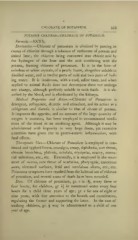Page 525 - My FlipBook
P. 525
CHLORATE OF POTASSIUM. 523
POTASSII CHLORAS—CHLORATE OF POTASSIUM.
Formula.—KCIO^.
Derivation.—Chlorate of potassium is obtained by passing an
excess of chlorine through a solution of carbonate of potassa and
slaked lime; the chlorine being converted into chloric acid by
the hydrogen of the lime and the acid combining with the
potassa, forming chlorate of potassium. It is in the form of
colorless or white crystals, of a pearly lustre, altogether soluble in
distilled water, and in twelve parts of cold and two parts of boil-
ing water. It is inodorous, with a cool, saline taste, and when
applied to animal fluids does not decompose them nor undergo
any change, although perfectly soluble in such fluids. It is ab-
sorbed by the blood, and is eliminated by the kidneys.
Medical Properties and Action.—Chlorate of Potassium is
detergent, refrigerant, diuretic and stimulant, and its action as a
refrigerant and diuretic is similar to that of nitrate of potassa.
It improves the appetite, and on account of the large quantity of
oxygen it contains, has been employed in contaminated condi-
tions of the blood as an oxidizing agent. Although it may be
administered with impunity in very large doses, yet excessive
quantities have given rise to gastro-enteric inflammation, with
fatal effects.
Therapeutic Uses.— Chlorate of Potassium is employed in con-
tinued and typhoid fevers, neuralgia, croup, diphtheria, sore throat,
chronic bronchitis, phthisis, scrofula, erysipelas, scurvy, mercu-
rial salivation, etc., etc. Externally, it is employed in the treat-
ment of ozaena, sore throat of scarlatina, pharyngitis, cancerous
sores, ulcerated surfaces, fetid and scrofulous ulcers, etc., etc.
Poisonous symptoms have resulted from the habitual use of chlorate
of potassium, and several cases of death have been recorded.
Dose.—Of chlorate of potassium, gr. v to 9j, every three or
four hours ; for children, gr. iij in sweetened water every four
hours for a child three years of age ; gr. v for one of eight or
nine years, with due attention to the bowels and constitution,
regulating the former and supporting the latter. In the case of
teething children, gr. ij may be administered to a child of one
year of age.


